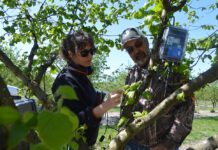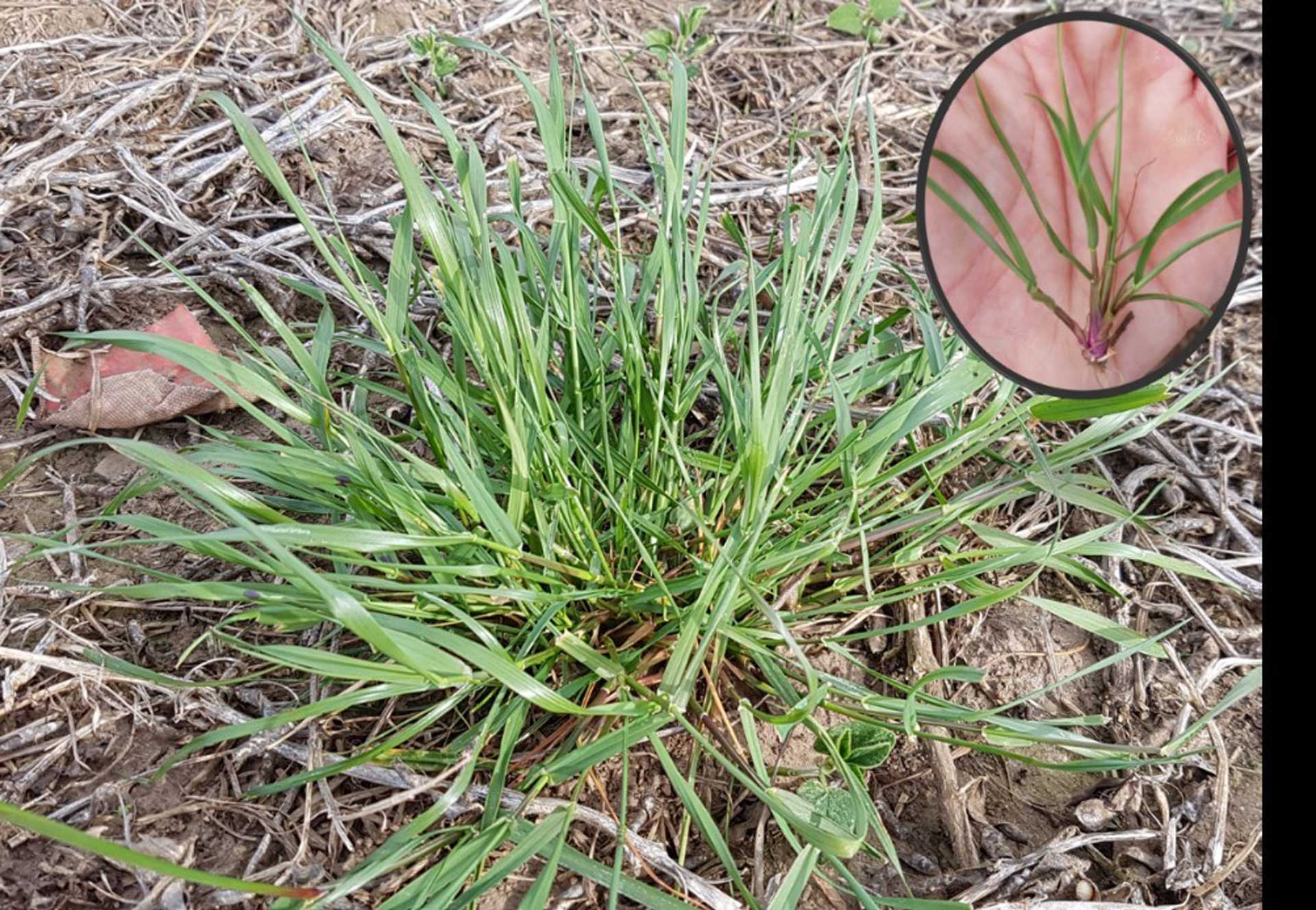
Hazelnut (Corylus avellana L.) is an economically important tree nut crop with a world market value of over $2 billion. The vast majority of the 88,000 acres of U.S. hazelnuts are grown in Oregon’s Willamette Valley due to ideal environmental conditions. Weed management is key to ensure high hazelnut yields by preventing weed competition, but also to maximize harvest efficiency as orchard floors must be kept weed- and debris-free to allow for efficient mechanized harvest.
Troublesome weeds such as Italian ryegrass (Lolium perenne L. spp. multiflorum; Fig. 1) can thrive in hazelnut orchards. This annual winter weed (Poaceae) grows across the world and is widely distributed throughout North America.
In Oregon, Italian ryegrass management has been complicated by the development of resistance to four herbicide sites of action (groups 1, 9, 10 and 15). Many factors influence Italian ryegrass management in Oregon hazelnut orchards. Dormant trees are generally planted during the mild winters, while rainfall is abundant. Although the fields are weed-free at planting, weed species such as Italian ryegrass quickly emerge, interfering with hazelnut orchard establishment. Furthermore, hazelnut acreage is rapidly expanding in Oregon, with bearing orchards reaching 60,000 acres in 2021, double the area of 2014. New orchards replace crops, including wheat and grass seed fields where herbicide-resistant weed populations have evolved under recurrent selection pressure. Increasingly, chemical control options become limited. Fields previously cropped with tall fescue or perennial ryegrass can also regrow these plants, requiring control.
At this time, herbicides are the primary means to control weeds in hazelnut orchards. In the wake of Italian ryegrass resistance to glyphosate and post-emergent graminicides, growers have been left with fewer chemical weed control options. Electricity has always sparked interest as a weed control method. Widespread adoption of this rarely used yet interesting control option has been limited due to safety concerns and cost of equipment.
More recently, the release of new technologies and equipment such as the one we have currently tested at Oregon State University has the potential to change this scenario. This technology could diversify weed management programs and reduce herbicide resistance selection.
Electric Control
Electric weed control exposes weeds to electrical energy. Efficient weed control is achieved when electrical energy is converted into heat for long enough, thus rupturing cell membranes and ultimately destroying the vascular bundle. However, many soil and plant factors impact the efficacy of electric weed control. Mineral composition, texture, temperature, porosity and moisture status (Fig. 2) affect soil resistivity and directly control how long the electrical pulse remains in the treated weed plant. In soils with high resistivity, as sandy soils do, the electrical energy is less likely to move from the treated plant into the soil. The weed receives a larger dose of energy and the outcome is better control (Zhou et al. 2015). Oregon hazelnuts are typically grown in silt and silty loam soils (medium-to-low resistivity), and we expect more energy to be required to provide similar control levels relative to silty sand or sandy soils. Plant factors, such as weed density, infestation and plant type, can also impact efficacy.
Plant factors such as weed density, infestation and plant type can also impact efficacy. The energy transmitted to a single plant (E) is proportional to electrode voltage (V) and contact time (Tc) (Vigneault and Benoit 2001). Further, the electrical resistance of the plant itself (Rp) will dictate how much energy moves throughout the plant.
Given the many variables involved, our research efforts are directed to evaluating the feasible use of electricity for herbicide-resistant weed control in Oregon orchards. An electric weeder (ZassoTM, Zug, Switzerland; Fig. 2) adapted for use in hazelnut orchards has been tested for control of herbicide-resistant Italian ryegrass in orchards near Corvallis, Ore. Two voltage settings (5 and 9 kV) and four application speeds (0.5, 1, 2 and 3 mph) were tested, and a nontreated control was included. Italian ryegrass plants were one to two feet tall at the time of treatment. Ryegrass shoot and inflorescence biomass were measured to provide control efficacy information.
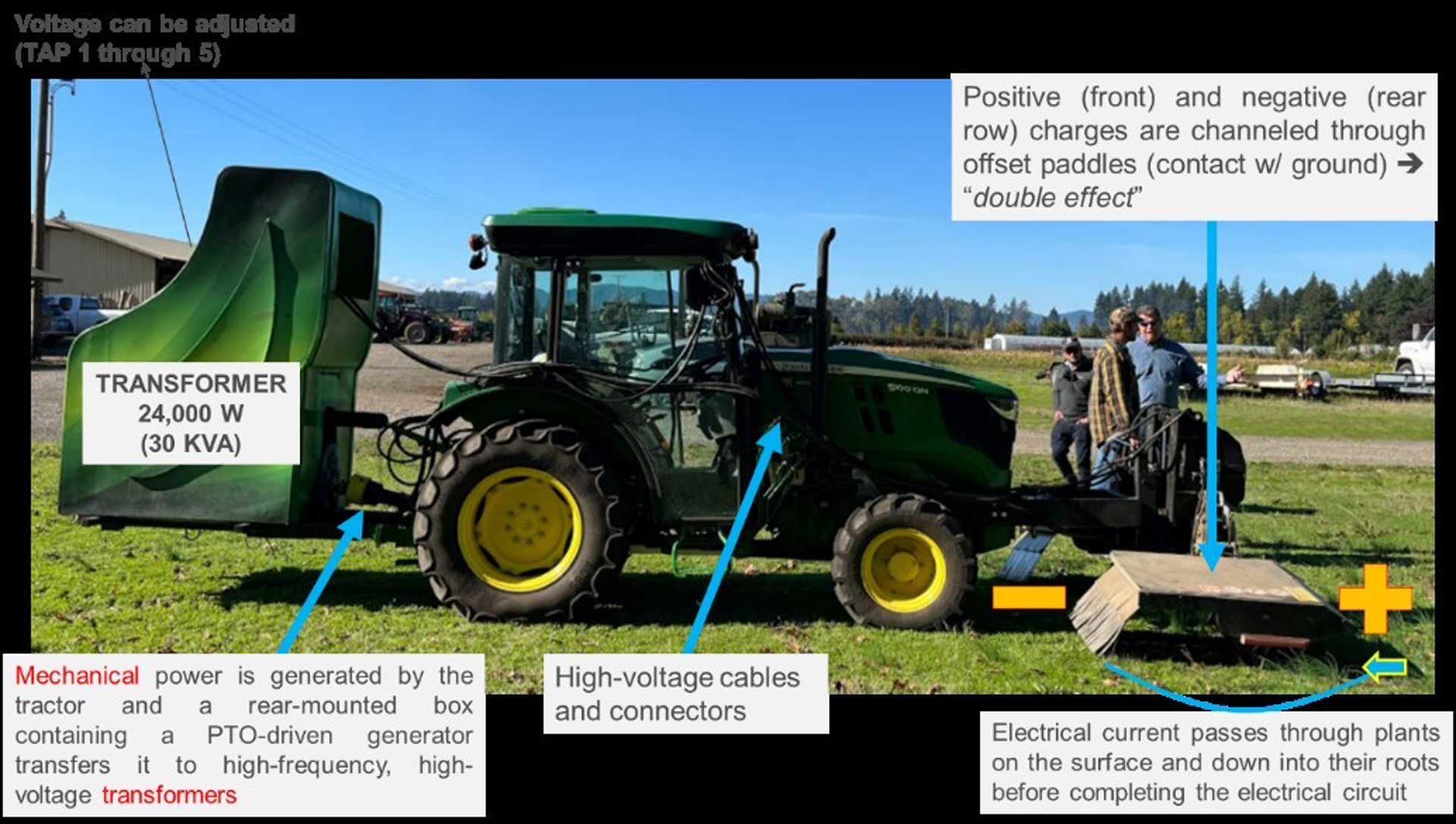
Results
Note: all results presented here are current. Treatment with the electric weeder caused rapid and significant damage to Italian ryegrass plants (Fig. 3). As expected, the best results were observed at lower speeds as the treated plants remain in contact with the equipment paddles, which are the source of the energy discharge.
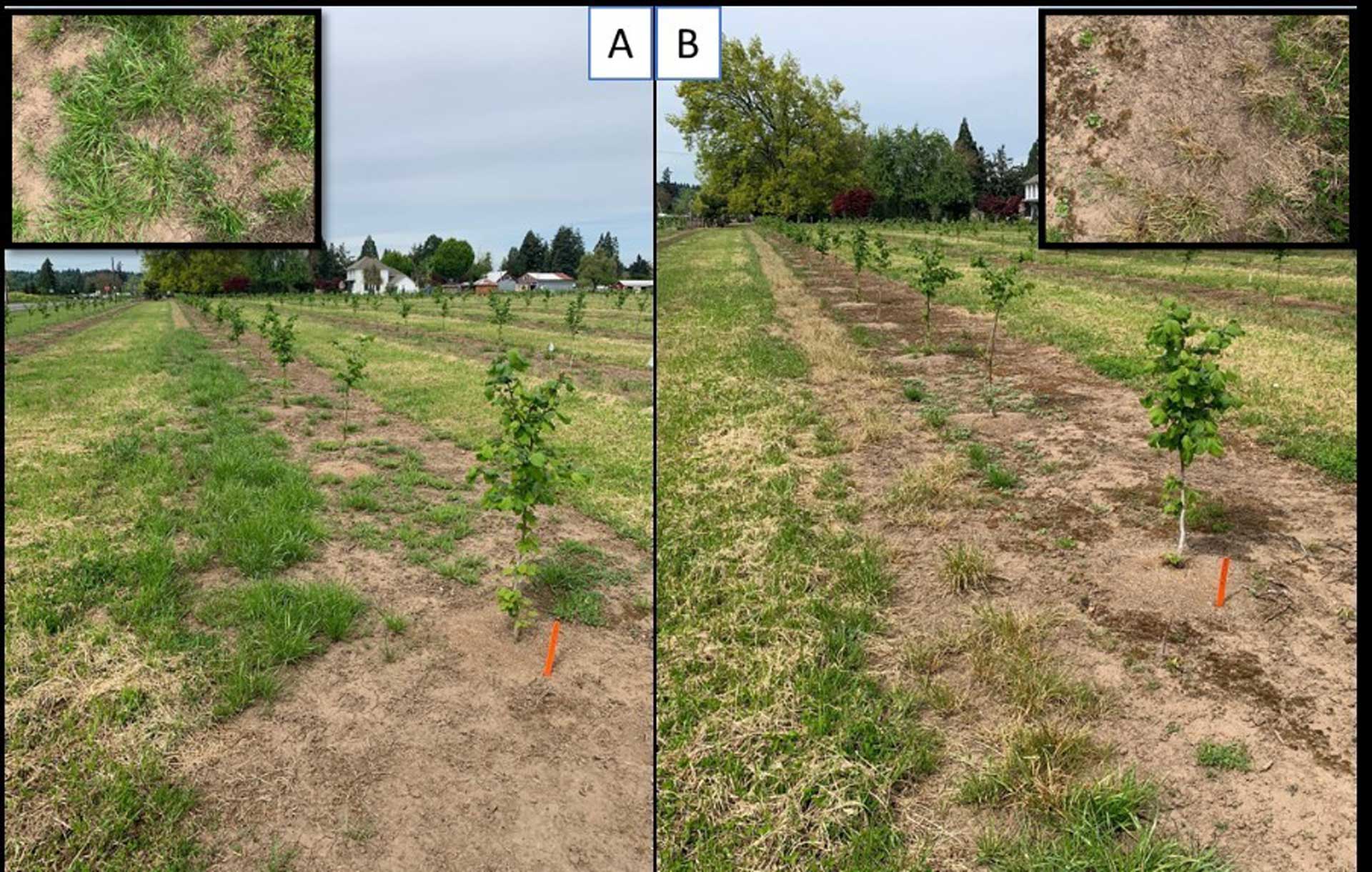
Italian ryegrass was well-controlled by treatments with 9 kV and application speeds of up to 2 mph. The same level of weed control was achieved with 5 kV treatments and an application speed of up to 0.5 mph (Fig. 4). The best voltage x speed combination was 9 kV at 2 mph. This combination resulted in a 90% decrease in shoot and a 70% decrease in ryegrass inflorescence biomass compared to the untreated control plants. Conversely, 5 kV did not decrease ryegrass biomass accumulation to such low levels, even at application speeds of 0.25 mph. We also observed that Italian ryegrass seedlings were easily controlled at any voltage setting. This is likely due to their less developed root systems and overall biomass.
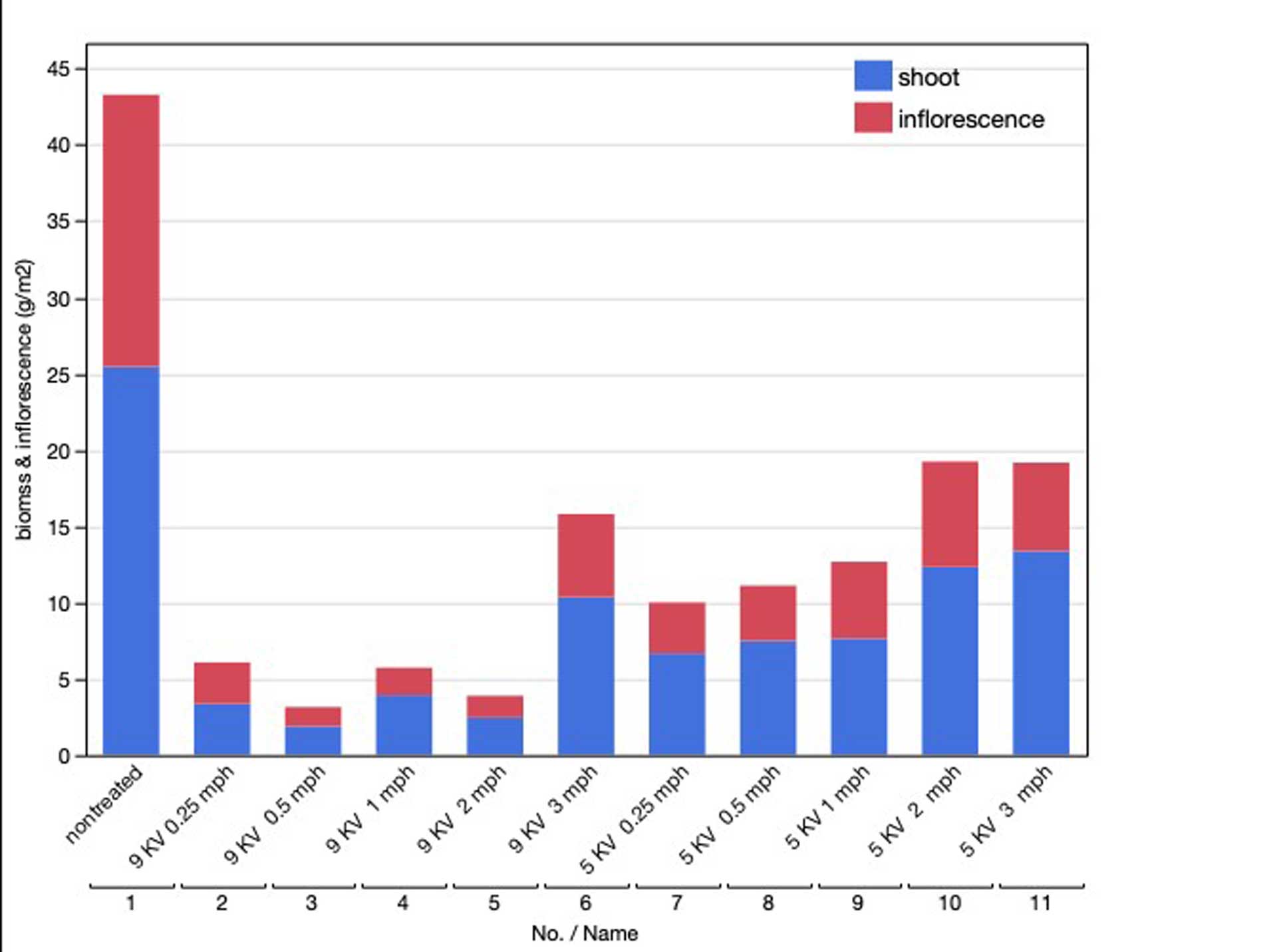
Our results suggest the possibility of integrating electric weed control into a more resilient weed management program designed to improve Italian ryegrass control in Oregon hazelnut orchards. We observed that grasses are more easily controlled with electricity than broadleaves are. Ongoing research efforts are focused on determining what makes some weed species more prone to die from electrocution and how much energy is lethal to various weed species.
We also observed damage to such troublesome species as yellow nutsedge (Cyperus esculentus L.) and horseweed (Conyza canadensis (L.) Cronq.) These species are currently under investigation, as are other factors that might affect electric weed control efficacy. One research question of special concern is how often electric weed control must be applied to deplete underground food reserves of weed species.
References
C. Vigneault and D.L. Benoit. “Electrical weed control: theory and applications,” in Physical Control Methods in Plant Protection, Vincent and Fleurat-Lessard, published by Springer-Verlag, New York, 2001, p. 174.
M. Zhou, J. Wang, L. Cai, Y. Fan and Z. Zheng, “Laboratory Investigations on Factors Affecting Soil Electrical Resistivity and the Measurement,” in IEEE Transactions on Industry Applications, vol. 51, no. 6, pp. 5358-5365, Nov.-Dec. 2015, DOI: 10.1109/TIA.2015.2465931.


